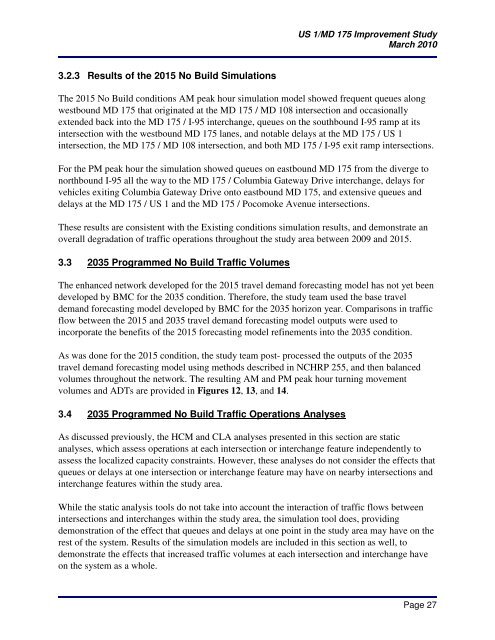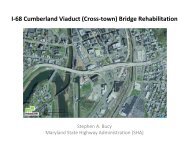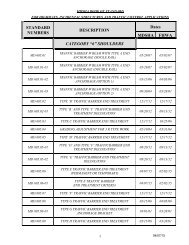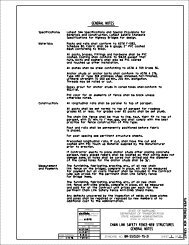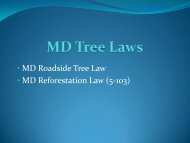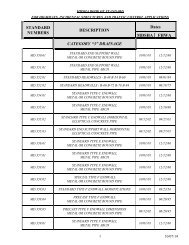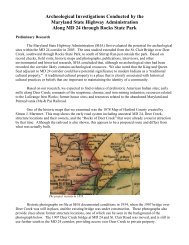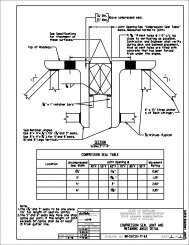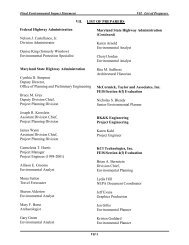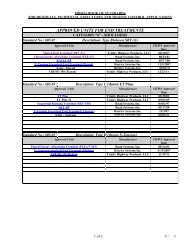US 1 / MD 175 Improvement Study Phase I Final Report March 2010
US 1 / MD 175 Improvement Study Phase I Final Report March 2010
US 1 / MD 175 Improvement Study Phase I Final Report March 2010
- No tags were found...
Create successful ePaper yourself
Turn your PDF publications into a flip-book with our unique Google optimized e-Paper software.
<strong>US</strong> 1/<strong>MD</strong> <strong>175</strong> <strong>Improvement</strong> <strong>Study</strong><strong>March</strong> <strong>2010</strong>3.2.3 Results of the 2015 No Build SimulationsThe 2015 No Build conditions AM peak hour simulation model showed frequent queues alongwestbound <strong>MD</strong> <strong>175</strong> that originated at the <strong>MD</strong> <strong>175</strong> / <strong>MD</strong> 108 intersection and occasionallyextended back into the <strong>MD</strong> <strong>175</strong> / I-95 interchange, queues on the southbound I-95 ramp at itsintersection with the westbound <strong>MD</strong> <strong>175</strong> lanes, and notable delays at the <strong>MD</strong> <strong>175</strong> / <strong>US</strong> 1intersection, the <strong>MD</strong> <strong>175</strong> / <strong>MD</strong> 108 intersection, and both <strong>MD</strong> <strong>175</strong> / I-95 exit ramp intersections.For the PM peak hour the simulation showed queues on eastbound <strong>MD</strong> <strong>175</strong> from the diverge tonorthbound I-95 all the way to the <strong>MD</strong> <strong>175</strong> / Columbia Gateway Drive interchange, delays forvehicles exiting Columbia Gateway Drive onto eastbound <strong>MD</strong> <strong>175</strong>, and extensive queues anddelays at the <strong>MD</strong> <strong>175</strong> / <strong>US</strong> 1 and the <strong>MD</strong> <strong>175</strong> / Pocomoke Avenue intersections.These results are consistent with the Existing conditions simulation results, and demonstrate anoverall degradation of traffic operations throughout the study area between 2009 and 2015.3.3 2035 Programmed No Build Traffic VolumesThe enhanced network developed for the 2015 travel demand forecasting model has not yet beendeveloped by BMC for the 2035 condition. Therefore, the study team used the base traveldemand forecasting model developed by BMC for the 2035 horizon year. Comparisons in trafficflow between the 2015 and 2035 travel demand forecasting model outputs were used toincorporate the benefits of the 2015 forecasting model refinements into the 2035 condition.As was done for the 2015 condition, the study team post- processed the outputs of the 2035travel demand forecasting model using methods described in NCHRP 255, and then balancedvolumes throughout the network. The resulting AM and PM peak hour turning movementvolumes and ADTs are provided in Figures 12, 13, and 14.3.4 2035 Programmed No Build Traffic Operations AnalysesAs discussed previously, the HCM and CLA analyses presented in this section are staticanalyses, which assess operations at each intersection or interchange feature independently toassess the localized capacity constraints. However, these analyses do not consider the effects thatqueues or delays at one intersection or interchange feature may have on nearby intersections andinterchange features within the study area.While the static analysis tools do not take into account the interaction of traffic flows betweenintersections and interchanges within the study area, the simulation tool does, providingdemonstration of the effect that queues and delays at one point in the study area may have on therest of the system. Results of the simulation models are included in this section as well, todemonstrate the effects that increased traffic volumes at each intersection and interchange haveon the system as a whole.Page 27


